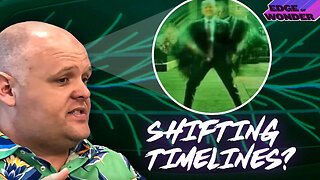The Shadow - 46/01/27 - Dream of Death
The Shadow is a collection of serialized dramas, originally in 1930s pulp novels and later in a variety of media. Its title character has been featured on the radio, in a long-running pulp magazine series, in American comic books, comic strips, television, serials, video games, and at least five feature films. The radio drama includes episodes voiced by Orson Welles.
After Welles departed the show in 1938, Bill Johnstone was chosen to replace him and voiced the character for five seasons. Following Johnstone's departure, The Shadow was portrayed by such actors as Bret Morrison (the longest tenure, with 10 years total in two separate runs), John Archer, and Steven Courtleigh (the actors were rarely credited).
The Shadow also inspired another radio hit, The Whistler, with a similarly mysterious narrator.
Margo Lane
The radio drama also introduced Margo Lane (played by Agnes Moorehead, among others) as Cranston's love interest, crime-solving partner, and the only person who knows his identity as The Shadow. Described as Cranston's "friend and companion" in many episodes, the exact nature of their relationship was not explicitly stated, but Margo mentions in the first episode that she loves him and hopes he will retire The Shadow identity and operate without secrecy if the police really need his help. Four years after the radio show began, the character was introduced into the pulp novels as one of The Shadow's agents. Her sudden, unexplained appearance in the pulps annoyed readers and generated a flurry of hate mail printed on The Shadow Magazine's letters page.
In early scripts of the radio drama, the character's name was spelled "Margot." The name itself was originally inspired by Margot Stevenson,[20] the Broadway ingénue who would later be chosen to voice Lane opposite Welles's The Shadow during "the 1938 Goodrich summer season of the radio drama." In the 1994 film in which Penelope Ann Miller played the character, Margo is portrayed as telepathic, making her aware of and able to counter The Shadow's mental abilities.
The Shadow, originally created to be a mysterious radio show narrator, was developed into a distinctive literary character in 1931 by writer Walter B. Gibson.
The Shadow debuted on July 31, 1930, as the mysterious narrator of the radio program Detective Story Hour, which was developed to boost sales of Street & Smith's monthly pulp Detective Story Magazine. When listeners of the program began asking at newsstands for copies of "that Shadow detective magazine", Street & Smith launched a magazine based on the character and hired Gibson to create a concept to fit the name and voice and to write a story featuring him. The first issue of the pulp series The Shadow Magazine went on sale April 1, 1931.
On September 26, 1937, The Shadow, a new radio drama based on the character as created by Gibson for the pulp magazine, premiered with the story "The Death House Rescue", in which The Shadow was characterized as having "the hypnotic power to cloud men's minds so they cannot see him". In the magazine stories, The Shadow did not become literally invisible.
The introductory line from the radio adaptation of The Shadow – "Who knows what evil lurks in the hearts of men? The Shadow knows!" - spoken by actor Frank Readick, has earned a place in the American idiom. These words were accompanied by an ominous laugh and a musical theme, Camille Saint-Saëns' Le Rouet d'Omphale ("Omphale's Spinning Wheel," composed in 1872).
The Shadow, at the end of each episode, reminded listeners, "The weed of crime bears bitter fruit! Crime does not pay...The Shadow knows!"
Some early episodes used the alternate statement, "As you sow evil, so shall you reap evil! Crime does not pay...The Shadow knows!"
For more about The Shadow:
https://en.wikipedia.org/wiki/The_Shadow
-
 LIVE
LIVE
Right Side Broadcasting Network
5 days agoLIVE: Day Two: 2024 Republican National Convention in Milwaukee, Wisconsin - 7/16/24
17,946 watching -
 2:09:30
2:09:30
Benny Johnson
6 hours ago🚨 EXCLUSIVE: Vivek, Trump LIVE Right NOW From Inside RNC! Talking Trump's Triumphant Return, WINNING
134K118 -
 58:37
58:37
Edge of Wonder
8 hours agoBizarre Premonitions, Dreams and the Future
65.8K9 -
 42:33
42:33
LFA TV
12 hours agoLIVE FROM THE RNC, BEHIND THE SCENES AS A DELEGATE | MIKE CRISPI UNAFRAID 7.16.24 5PM EST
102K22 -
 1:26:36
1:26:36
Redacted News
8 hours agoBREAKING! THIS CHANGES EVERYTHING, NEW DETAILS IN TRUMP ASSASSINATION | Redacted w Clayton Morris
251K694 -
 6:05:55
6:05:55
Jerry After Dark
10 hours agoJerry After Dark: Home Run Record Challenge presented by Gametime
205K5 -
 48:02
48:02
Kimberly Guilfoyle
13 hours agoDonald Trump is the man in the arena, live coverage from the RNC
159K185 -
 1:03:11
1:03:11
In The Litter Box w/ Jewels & Catturd
1 day agoFear The Beard | In the Litter Box w/ Jewels & Catturd – Ep. 605 – 7/16/2024
177K56 -
 1:15:09
1:15:09
Awaken With JP
11 hours agoWhat Happens Next? - LIES Ep. 48
180K215 -
 2:20:28
2:20:28
Darkhorse Podcast
10 hours agoCave of Mirrors: The 234th Evolutionary Lens with Bret Weinstein and Heather Heying
119K110